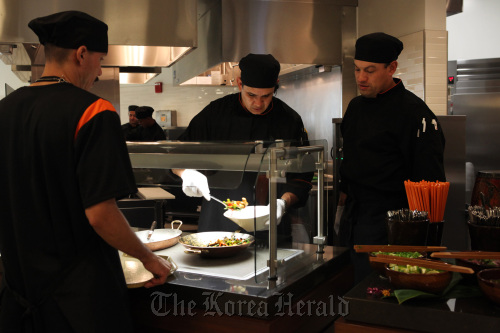LOS ANGELES ― Don’t look for macaroni and cheese, hamburgers or tuna melt sandwiches at the renovated dining commons at UCLA’s Rieber Hall dormitory. Instead, a hungry student will find such dishes as spinach and seaweed roll, pork ramen with miso, Buddha’s delight and chicken tikka masala.
The 600-seat facility offers exclusively Asian-style food from seven national cuisines. And in case visitors don’t realize that something different is going on, hosts welcome them in several Asian languages and video screens broadcast cable news shows from Japan, South Korea, India and other countries.
The upscale dining hall, which opened last week, is part of a trend by colleges nationwide to replace old-style cafeterias and “mystery meat” offerings with innovative, often ethnic fare more likely to appeal to undergraduates’ increasingly sophisticated palates and desire for healthier food.
The changes reflect a broad push at many schools to improve campus housing, recreation and other amenities in order to attract students. Critics say the trend drives up costs unnecessarily, although officials say that is not the case with the UCLA project.
The changes at Rieber are also a response to demographics: About 40 percent of UCLA’s 27,000 undergraduates are Asian American or international students from Asia.
“They are all coming with dining experiences that they remember as good food and authentic food for their culture, and that’s what we want to celebrate and deliver in a very authentic way,” said Peter L. Angelis, assistant vice chancellor of housing and hospitality services.
He and other officials emphasize that the new facility is designed to appeal to students of all backgrounds. Those who do not want to eat there can use their campus meal cards for American, Mexican, Italian and other fare at nearby dining halls and cafes.
 |
Assistant cooks Jose Espenoza (center) and Moses Mendez (right) work behind the counter to serve up a dish of Thai stir fry pork with long beans at UCLA’s new dining hall. (Los Angeles Times/MCT) |
Compared to previous generations, today’s college students “are much more food-savvy. They are more used to going out to eat and more used to restaurant environments and restaurant-quality of food,” said Daryl Ansel, UCLA’s residential food and beverage director.
As a result, many schools are “upgrading their ambience and the menus to get more of a restaurant feel and experience for the students,” said Nona Golledge, president of the National Association of College & University Food Services. Experiencing good food in a nice setting can influence a student’s choice of a college and continuing relationship with it, said Golledge, who is dining services director at the University of Kansas.
Nationwide, campuses big and small, private and public have joined the “foodie” trend.
At the University of San Diego, a dining hall has Mexican, Italian, Japanese, Chinese and vegetarian stations. Harvey Mudd College in Claremont rotates sushi, Mongolian wok dishes and a Brazilian-style grill among its menus. Wellesley College in Massachusetts has a vegetarian dining hall and the University of North Texas has one for vegans and another for Southern home-style and Cajun cooking. At the University of Notre Dame, a new cafe features low-sodium, low-fat fare with local, seasonal ingredients. And the University of Missouri, Columbia, boasts of one where chefs prepare each order individually.
Today’s students “know what a portabello mushroom is,” explained Scott Meyer, food service director at the University of Texas, where a recently redone dining hall offers blackened catfish, Mexican wraps and pho noodles.
One of a cluster of high-rise dorms in an area of the UCLA campus known as “the hill,” the 1963 Rieber building recently underwent a major renovation. Administrators figured it was a good time to give its ground-level dining hall a new look and focus. It appears to be one of the most ambitious featuring ethnic food at any U.S. college, experts say. Its name, “FEAST at Rieber,” is a wordplay about food from the East.
The preparation of unusual dishes on a mass scale has proved tougher and more time-consuming than anticipated, officials said. So while lunch for meal plan students became available at Rieber Monday, dinner may not be offered until winter term, and others won’t be able to buy meals there until student demand is clear, officials say. (Most UCLA meal plans are combined with dorm bills and vary with room arrangements and other specifics.)
Dishes from China, Japan, Thailand, Vietnam, Korea, India and Hawaii will be offered, pairing two countries for each meal. UCLA chefs sampled ethnic restaurants around Southern California and asked students to be taste-testers, recommending spice levels that are authentic but not overwhelming.
At first, about 300 dishes will rotate, including Japanese soba noodles with asparagus, Chinese eggplant with garlic sauce, Vietnamese fried fish sandwich, Hawaiian pork flatbread, Indian potato croquettes, Thai red curry fries and Korean ginger and rice punch.
With a multiethnic student body, UCLA wanted to provide home-style Asian food that might otherwise be available only off campus, Angelis said. Learning about the foods of other cultures may also have a positive social effect, helping students to be more respectful of one another, he said.
Asked whether students might appear spoiled with fancy campus amenities, Angelis pointed out that many live three to a room in spaces designed for two. As a result, he said, dining halls are an important communal space.
“When they look back at their college experience, a big part of the memory is the social experience of who your friends were and where did you eat,” he said.
By Larry Gordon
(Los Angeles Times)
(MCT Information Services)







![[Today’s K-pop] Blackpink’s Jennie, Lisa invited to Coachella as solo acts](http://res.heraldm.com/phpwas/restmb_idxmake.php?idx=644&simg=/content/image/2024/11/21/20241121050099_0.jpg)
